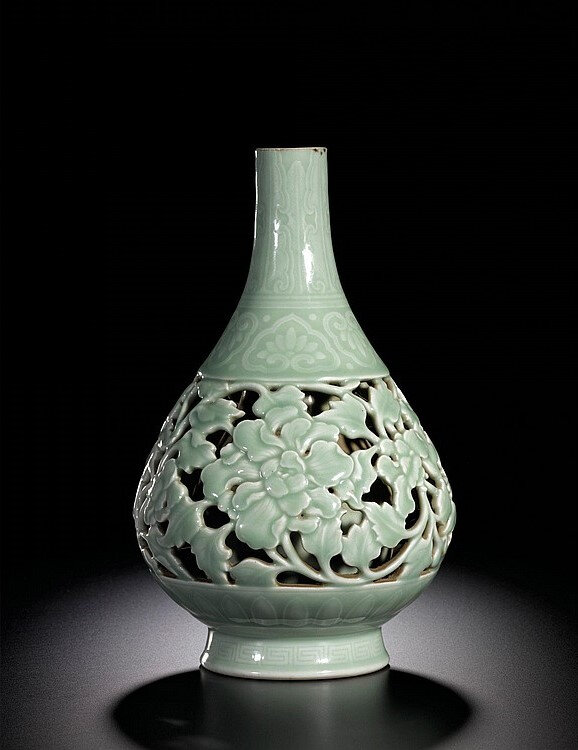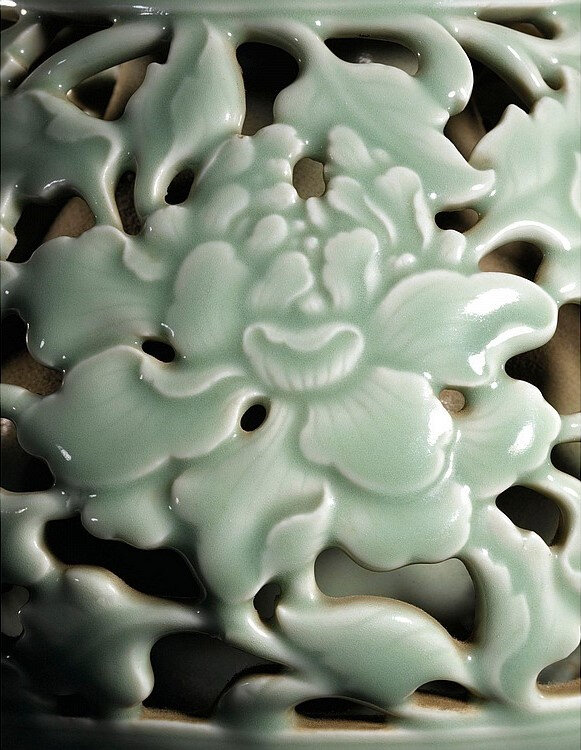An extremely rare pear-shaped reticulated celadon-glazed vase, Seal mark and period of Qianlong (1736-1795)

Lot 3024. An extremely rare pear-shaped reticulated celadon-glazed vase, Seal mark and period of Qianlong (1736-1795); 27 cm., 10 5/8 in. Estimate 2,500,000 — 3,000,000 HKD. Lot Sold 4,820,000. Photo Sotheby's
the elegantly potted bottle vase with a gently swelling belly sweeping up to a truncated cylindrical neck, masterfully engineered with a deftly reticulated band of three large peonies with lush petals encircled by scrolling leaves subtly incised with veining, the openwork areas revealing a plain integral vase beneath, all below a finely carved low-relief band of upright plantain leaves collaring the cylindrical neck and detached ruyi heads each containing stylised lotus flowers around the shoulder, supported on a carved lotus petal band skirting the base and a low foot incised with a key-fret band, all beneath a glassy tea-green celadon glaze pooling in the recesses creating layers of depth, the base marked with a six-character reign mark in underglaze blue.
Provenance: Collection of John Jacob de Pass, Middleton Hall, Norfolk, England. Acquired in Shanghai in the 1890s, and hence by descent to the present owner.
The present vase was acquired by John Jacob de Pass, who travelled extensively to China and was a keen collector of Chinese works of art. The bulk of his collection was dispersed after his death in 1923.
Note: Beautifully potted and glazed, this vase is a fine example of double-walled reticulated vessels made during Qianlong's reign. Only two other similar examples are known; a vase in the Palace Museum, Beijing, illustrated in Zhongguo taoci quanji, vol. 15, Shanghai, 2000, pl. 85; and one sold in these rooms, 8th April 2009, lot 1603.
The inspiration for this vase, and the two mentioned above, came from a much earlier, 15th century, Longquan example; see a remarkably close copy of a Longquan piece in the Samuel P. Harn Museum of Art, University of Florida, Gainesville, Florida, sold in our New York rooms, 22/23rd September 2004, lot 205. There is mentioning of openwork vases imitating Longquan ware in two Qing court records dated to 1742 and 1743. Tang Ying, superintendent at the Imperial Kilns at Jingdezhen, submitted a memorial to the Qianlong emperor recording his presentation to the court of a total of nine 'layered openwork' and interlocking vases. (See Liao Pao Show's introduction in the exhibition catalogue Stunning Decorative Porcelainsfrom the Ch'ien-lung Reign, National Palace Museum, Taipei, 2008, pp. 27. The present vase clearly bears the signature of Tang Ying's craftsmanship for its elegant restricted decorative scheme.
Sotheby's. Fine Chinese Ceramics and Works of Art, Hong Kong, 08 april 2011

/https%3A%2F%2Fprofilepics.canalblog.com%2Fprofilepics%2F1%2F0%2F100183.jpg)
/https%3A%2F%2Fstorage.canalblog.com%2F03%2F02%2F119589%2F96711876_o.jpg)
/https%3A%2F%2Fstorage.canalblog.com%2F11%2F31%2F119589%2F94773502_o.jpg)
/https%3A%2F%2Fstorage.canalblog.com%2F20%2F83%2F119589%2F94772815_o.jpg)
/https%3A%2F%2Fstorage.canalblog.com%2F26%2F72%2F119589%2F75604929_o.jpg)
/https%3A%2F%2Fstorage.canalblog.com%2F59%2F60%2F119589%2F26458628_o.jpg)




/image%2F1371349%2F20240402%2Fob_9318b6_130-1.jpg)
/image%2F1371349%2F20240402%2Fob_7227e1_129-1.jpg)
/image%2F1371349%2F20240402%2Fob_e7099e_128-1.jpg)
/image%2F1371349%2F20240401%2Fob_834d8f_telechargement.jpg)